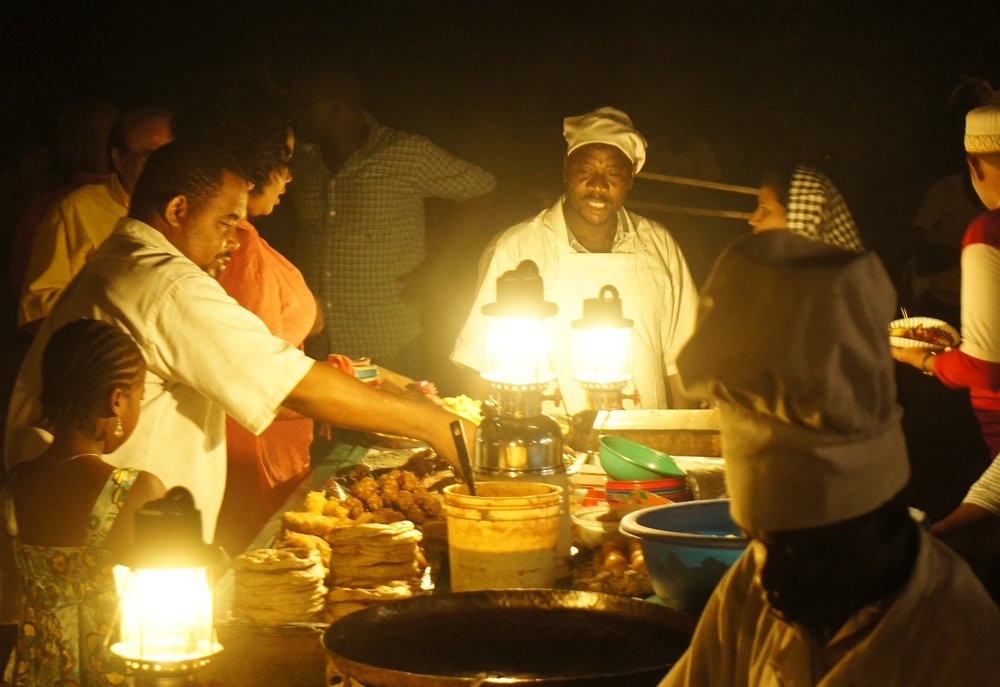
The old quarter of Zanzibar city is a charming maze of narrow streets, gorgeous architecture, historic ruins, and spice stores and coffee shops. To make the most of a day in this part of the city, here’s where you should eat, what you should see, and where you should go with just 24 hours in Stone Town.
Stone Town wakes up early, starting with the first prayer call, then church bells, followed by government workers cleaning the streets and kids hurrying to school. The beach is full of people exercising — runners, yogis, aerobics groups, swimmers. If you are up to it, join them!
Breakfast time is actually a wonderful moment to hit the streets to find freshly fried chapati breads, uji porridge and other breakfast delicacies. Stone Town is built so that there is almost always a baraza to sit on — they are lining the streets, making the whole town a communal area. Even though barazas technically belong to houses, they are considered shared space, so don’t hesitate to sit on them and have a chance to meet some locals.
Zanzibar is infamous as the centre of slave trade in the 19th century, and the best way to learn about the human suffering that this caused is by visiting the Old Slave Market museum. The Anglican church built at the old auction place is full of symbolism, the architecture still bearing the memory of the old days.

The market is well worth taking a long time to explore | Photo by Zanzibar Urban Adventures
Another, less troubling trade that made Zanzibar famous are the spices that have been and still are grown on the islands. Walking at the Darajani market area will take you through household items, fish, meat, vegetables, fruits and then, finally, the spice section. It’s the ultimate destination for souvenir shopping as well. You can then continue through the dozens of bazaar shops on Khanga Street showcasing Tanzanian and other African textiles.
Another interesting stop is the People’s Palace Museum, which takes you back to the times of the sultans. Most of the museum is kept as it was during different eras, latest dating to the ’60s when the last sultan had to run from Zanzibar after the 1964 revolution.
The steamy afternoon hours require a break from the streets after an active morning. Stone Town is a home to many great restaurants serving both Swhaili foods and international cuisine. An easy and breezy stop at The Post, on the second floor of the actual post office, gives a chance to have lunch and even a beer to go with it, which is not the case with most lunch restaurants in town.
There are three different restaurants to choose from, offering tapas, salads, Thai and Swhaili dishes. From the balcony you have a view of the Kenyatta Road, the main street of Stone Town. Write the postcards you plan to send home and check out the designer shops in the area.

You can pay a visit to these guys | Photo by Zanzibar Urban Adventures
Stone Town is indeed built mostly of stone, but it’s also surrounded by the ocean. Many don’t think of it, but there are some great snorkelling waters just nearby. A trip to Prison Island takes you on a boat to admire the beautiful waterfront of the town and to explore the island, which despite its name has mostly served as a quarantine station. It also holds a sanctuary for the giant tortoise community originally brought to the island in 1919 from Seychelles.
Prison Island also has a great beach with the unique view of Stone Town, and a short boat trip away there are colourful coral reefs to snorkel. The turquoise Indian Ocean is the best way to wash off the dust of the historical streets and remind you why Zanzibar is the exotic paradise it is, with the unique mixture of culture, history and nature.
Evenings in Stone Town are full of life and the streets are generally very safe. The Emerson on Hurumzi hotel offers the best treat in town for evenings, with great cuisine and a lovely Zanzibari setting for rooftop dinners. Reservations need to be made beforehand, and it’s wise to come before the sun sets, as this is perhaps the highest rooftop in town and has breathtaking views.

Forodhani is the place to be | Photo by Zanzibar Urban Adventures
Zanzibar is the home of taarab music, a mixture of traditional Arabic tunes, Swahili lyrics and African rhythms. The nearby Dhow Countries Music Academy has its best students playing at the Hurumzi dinners, singing enchanting taarab songs.
After dinner, there is one thing all the town people agree on: Forodhani is the place to be. A beautiful seaside park during the daytime, this place comes to life after sunset with street food and cafes. It’s a place where everyone meets — the young and elderly, families and friends, locals and visitors. Enjoying some spicy masala tea or sugarcane juice while people-watching is the favourite pastime, and a perfect ending to a full day in Stone Town.